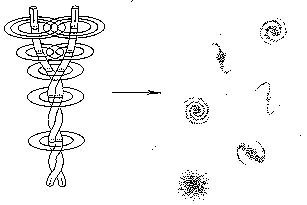Introduction
Recent reports of "wrinkles" in space have been promoted as a major victory for the Big Bang. This may or may not help explain the large-scale structure of the universe. Meanwhile, other fundamental problems remain, such as the origin of galaxies. The plasma model for the origin of the universe has arrived just in time to compete with the troubled Big Bang. 1
A popular book with the title, The Big Bang Never Happened, has summarized some of the weaknesses. Unfortunately, the writer is just as naive about origins as those he attacks: "Since nowhere do we see something emerge from nothing, we have no reason to think that this occurred in the distant past." 2 So much for an honest consideration of ex nihilo creation! The possible replacement for the Big Bang, plasma cosmology, is not really new; physicists like Hannes Alfven and Tony Perratt have been quietly promoting it for years. We will surely hear much more about the possible demise of the Big Bang and the rise of the plasma universe during the 1990's. 3
The name "plasma" is applied to a high temperature gas when the outer electrons become separated from their atoms. It is a plasma which glows inside a fluorescent tube or an advertising sign. It also comprises such phenomena as lightning and the Northern Lights. The sun and most other stars are themselves giant spheres of plasma gas. The astronomy word plasma was actually borrowed from medicine, where it identifies the colorless fluid component of the blood in which corpuscles are suspended. The term is well chosen, since ionized matter often appears to swirl and change in a lifelike manner.

Figure 1. The tubes represent vast electrical currents of plasma in space; the circles show magnetic fields which surround the currents. In the plasma universe, galaxies are gradually formed by plasma interactions.
In the proposed plasma universe, deep space is permeated with giant filaments of electrons and ions. These are not the hypothetical cosmic strings which supposedly involve higher dimensions of space. Instead, the plasma strands are thought to be real, physical entities. It is further proposed that these filaments twist together in space due to electromagnetic forces. Some of their vast energy is then converted into matter, and new galaxies are the eventual result (Figure 1). This plasma "theory of everything" seeks to explain almost every cosmic detail. Thus the intricate spiral arms of galaxies are said to reveal further interactions of the plasma filaments. Since galaxies contain 100 billion stars each and are 100 thousand light years across, the proposed plasma strands are clearly of immense energy and size. Cosmologists are not known for restraint in their speculation! Halton Arp concludes: "Cosmology is unique in science in that it is a very large intellectual edifice based on very few facts. Certainty in science cannot be forthcoming from minimal positions such as those which currently exist in cosmology." 4
A workable mechanism for star and galaxy formation from interacting plasma gases is not known. But, of course, such details were never understood for the Big Bang either!
At first hearing, the plasma theory is attractive in that it nicely avoids some of the Big Bang problems. First, galaxy formation by tangled plasma strands might explain the large scale structure or "lumpiness" of the universe. If the initial plasma is not uniformly distributed, neither will be the resulting galaxies. Second, an overall radiation "fog" produced by cosmic plasma energy might result in the well-known smooth background radiation, usually attributed to initial heat from the Big Bang. Third, new mechanisms for a non-velocity red shift of starlight may be important; thus the plasma theory challenges even the basic assumption of an expanding universe.
For the creationist, there is also a serious "downside" to the plasma universe. Four problems will be given: First, plasma adherents assume that the ionized universe is infinite in both age and size. That is, the universe is countless trillions of years old, and it will never end. This is really just a crafty way of saying that origin and destiny questions are meaningless! These important questions are ruled off limits by definition. With an infinite time scale, the plasma approach is much like the Steady State Theory of the 1950's (Table 1). Both of these theories, in turn, echo the anti-creation view of geologist James Hutton. In his Theory of the Earth (1785), he wrote about endless processes on the earth with "No vestige of a beginning, no prospect of an end."
| Theory | Era of Popularity |
| Steady State | 1950's - 60's |
| Big Bang | 1960's - 80's |
| Plasma | 1990's |
Table 1. A summary of modern, naturalistic cosmological theories for the origin and order of the universe.
Second, the plasma universe fully accepts all aspects of slow stellar evolution, without reservation. In fact, hundreds of billions of years are assumed to be available for stellar processes.
Third, the plasma universe is built on a wholesale extrapolation of size, over a scale of at least 1028. That is, the observed behavior of plasma in a small laboratory chamber is assumed to be duplicated on the vastly larger scale of galaxy clusters. Obviously, such unlimited extrapolation is unjustified. It is like studying a grain of dust and then equating its properties to a boulder that is a billion light years in diameter. As another comparison, consider that the divergent time views of evolutionists and recent creationists differ by "only" a factor of 106, 10 thousand years versus 10 billion. The unwarranted extrapolation of plasma properties throughout deep space is all too common in astronomy. It is similar to the modeling of galaxy formation on a computer, and then declaring that the computer simulation is reality. Must creationists be the only ones to blow the whistle on this poor logic?
Fourth, the plasma universe assumes that electric and magnetic forces are dominant in space instead of gravity. However, it has not been shown that electromagnetism is capable of forming and shaping galaxies, even with unlimited time.
The plasma universe is currently enjoying success as a "Big-Bang basher." In due course, its own weaknesses will begin receiving more attention. The lesson is clear: Creationists should be especially cautious about accommodating new science ideas, even if they oppose evolutionary models like the Big Bang. The replacement may be even worse than the original problem! Steady State, Big Bang, Plasma — naturalistic theories of origins will continue to rise and fall.
Further, the current crisis of theistic evolution in defending the Big Bang shows the embarrassing result of compromise. Those who have wrongly inserted the Big Bang into Genesis may someday be the only ones left to defend the idea of an initial explosion! The creation of the universe was supernatural, by definition, and will always remain beyond the understanding of skeptical cosmologists. This is not to say that the creation view closes the door to inquiry. Instead, it accepts the refreshing and truthful fact that there are limits to the domain of natural science.
As matters stand at present, there is no better astronomic theory for the origin of the universe than the inspired explanation of Scripture. "By the word of the LORD were the heavens made; and all the host of them by the breath of His mouth. . . . For He spake, and it was done; He commanded, and it stood fast" (Psalm 33:6,9). ". . . for He commanded, and they were created" (Psalm 148:5).
[1] Duane Gish, "Big Bang Theory Collapses," Impact No. 216 (June 1991): pp. i-iv.
[2] Eric Lerner, "The Big Bang Never Happened," (New York: Random House, 1991), p. 41.
[3] Eric Lerner, "The Cosmologists' New Clothes," Sky and Telescope, 83 (February 1992):124. Geoffrey Burbidge, "Why Only One Big Bang?" Scientific American, 266 (February 1992): 120.
[4] H. C. Arp, et al., "The Extra-Galactic Universe: An Alternative View," Nature 346 (August 30, 1990): pp. 807-812.* Dr. Don DeYoung (Ph.D., Iowa State University) is Professor of Physics at Grace College, Winona Lake, Indiana, as well as Adjunct Professor of Astrophysics at the ICR Graduate School.
















